-
current
recommendations- Liefdefjord
New page dedicated to one of Spitsbergen's most beautiful fjords. Background information and many photos.

- New Spitsbergen guidebook
The new edition of my Spitsbergen guidebook is out and available now!

- Liefdefjord
New page dedicated to one of Spitsbergen's most beautiful fjords. Background information and many photos.
Seitenstruktur
-
Spitsbergen-News
- Select Month
- April 2024
- March 2024
- February 2024
- January 2024
- December 2023
- November 2023
- October 2023
- September 2023
- August 2023
- July 2023
- June 2023
- May 2023
- April 2023
- March 2023
- February 2023
- January 2023
- December 2022
- November 2022
- October 2022
- September 2022
- August 2022
- July 2022
- June 2022
- May 2022
- April 2022
- March 2022
- February 2022
- January 2022
- December 2021
- November 2021
- October 2021
- September 2021
- August 2021
- July 2021
- June 2021
- May 2021
- April 2021
- March 2021
- February 2021
- January 2021
- December 2020
- November 2020
- October 2020
- September 2020
- August 2020
- July 2020
- June 2020
- May 2020
- April 2020
- March 2020
- February 2020
- January 2020
- December 2019
- November 2019
- October 2019
- September 2019
- August 2019
- July 2019
- June 2019
- May 2019
- April 2019
- March 2019
- February 2019
- January 2019
- December 2018
- November 2018
- October 2018
- September 2018
- August 2018
- July 2018
- June 2018
- May 2018
- April 2018
- March 2018
- February 2018
- January 2018
- December 2017
- November 2017
- October 2017
- September 2017
- August 2017
- July 2017
- June 2017
- May 2017
- April 2017
- March 2017
- February 2017
- January 2017
- December 2016
- November 2016
- October 2016
- September 2016
- August 2016
- July 2016
- June 2016
- May 2016
- April 2016
- March 2016
- February 2016
- January 2016
- December 2015
- November 2015
- October 2015
- September 2015
- August 2015
- July 2015
- June 2015
- May 2015
- April 2015
- March 2015
- February 2015
- January 2015
- December 2014
- November 2014
- October 2014
- September 2014
- August 2014
- July 2014
- June 2014
- May 2014
- April 2014
- March 2014
- February 2014
- January 2014
- December 2013
- November 2013
- October 2013
- September 2013
- August 2013
- July 2013
- June 2013
- May 2013
- April 2013
- March 2013
- February 2013
- January 2013
- December 2012
- November 2012
- October 2012
- September 2012
- August 2012
- July 2012
- June 2012
- May 2012
- April 2012
- March 2012
- February 2012
- January 2012
- December 2011
- November 2011
- October 2011
- September 2011
- August 2011
- May 2011
- April 2011
- March 2011
- February 2011
- January 2011
- December 2010
- November 2010
- September 2010
- August 2010
- July 2010
- June 2010
- May 2010
- April 2010
- March 2010
- February 2010
- November 2009
- October 2009
- August 2009
- July 2009
- June 2009
- May 2009
- April 2009
- March 2009
- February 2009
- January 2009
- December 2008
- November 2008
- October 2008
- August 2008
- July 2008
- June 2008
- May 2008
- April 2008
- March 2008
- February 2008
- April 2000
- Select Month
-
weather information

| THE Spitsbergen guidebook |
Pyramiden - Dickson Land - Billefjord
D = Dickson Land
P = Pyramiden
B = Brucebyen
L = Long-
yearbyen
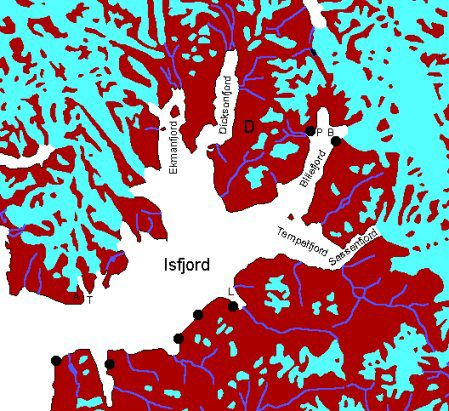
General: Dickson Land is the name for the peninsula between Dicksonfjord and Billefjord. It is named after a Swedish industrial of the 19th century, who sponsored several Swedish expeditions. The Billefjord is very scenic, including the large calving glacier front of Nordenskiöldbreen. Because of this and because of the short distance to Longearbyen, the Russian mining settlement Pyramiden (closed in 1998), it is frequently visited especially in the summer, when boats do day trips into the Billefjord from Longyearbyen. Visits have become somewhat less frequent sinc Pyramiden is closed, but Dickson Land is still one one the most beautiful and easily accessible hiking and trekking areas of Spitsbergen. Long trekkings following the large, ice-free valleys and high plateaus are possible as well as some mountain climbing (not technical) and glacier hikes – provided safe stepping, good physical shape and relevant equipment and experience (see rules).
Geology: The area around the Billefjord belongs to the geologically most interesting regions of Svalbard. The pre-devonian basement is exposed only near the Nordenskiöld-glacier and to the north of the Billefjord. On both sides of the fjord, but especially in western and northern Dickson Land, reddish sandstones and conglomerates of the Devonian Old Red give the landscape an appereance with beautiful colours. Tree trunks found in these rocks are of truly respectable age, and together with the Devonian coal seams which were mined in Pyramiden, they belong to the oldest fossilised remains of large plants on Earth – most coal occurrences worldwide date to the younger Carboniferous or are even younger. Vegetation which could potentially be turned into coal later just started to cover the first land surfaces in the Devonian. In the Carboniferous and Permian, various sediments were deposited, among others evaporites such as gypsym and anhydrite. These multicoloured sediments give the landscape a colourful appareance, for example the slopes of the mountains near Brucebyen and north of the Billefjord. There is one mountain called Trikolorfjellet (‘Three colour mountain’). In the Permian, deposition continued mostly with carbonates, among others the hard, fossil-rich limestones of the Kapp Starostin Formation. In the Dickson Land, they often form prominent cliffs, over which sometimes waterfalls cascade down.
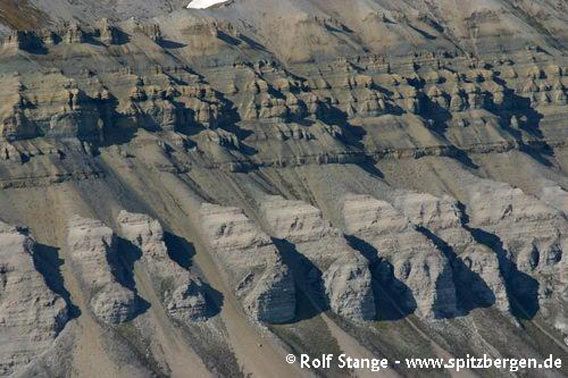
Almost horizontal layers of Carboniferous and Permian sediments, dissected by erosion to form protruding towers (Skansbukta).
After a break in the uppermost Permian, the typical Mesozoic ‘platform sediments’ were deposited in most parts of Svalbard, including Dickson Land, where they are preserved in the southern part, as the strata are gently dipping to the south. Lithologically, they are similar to the Triassic succession of Edgeøya, also including doleritic intrusions from the upper Jurassic and Cretaceous. Phosphoritic concretions within the Triassic sediments of southern Dickson Land were tought to be economically exploitable, which lead to investigations by Swedish expeditions, among others with Adolf Erik Nordenskiöld. The name ‘Saurierdalen’ points to fossils found in southern Dickson Land.
The lively history of regional tectonics gave rise to an interesting geological variety within a relatively small area. The rocks are partly aesthetically folded. The Billefjorden fault zone runs straight through the long Wijdefjord in the north and through the Billefjord. This is one of the most important tectonic lineaments in Svalbard, it has got a long and complex history starting well before the Caledonian orogeny in the Silurian and lasting at least into the Mesozoic. This structure has been decisive for regional erosion, sedimentation and later deformation: uplifted blocks on one side suffered erosion, whereas the subsiding block on the other side was covered with sediments. Actually, the Billefjorden fault zone is not only one straight fault, but rather a complex zone of a number of faults. This is nicely visible for example north of Hørbyebreen.
Another tectonic event happened in the uppermost Devonian, the so-called Svalbardian Phase, a very late and final stage of the Caledonian orogeny which is otherwise largely confined to the Silurian. The result of regional uplift and tilt is a discordance between the Devonian Old Red and the upperlying Carboniferous carbonates. This is nicely visible, as the relatively soft Devonian sandstones and conglomerates form soft, reddish slopes topped by steep cliffs of yellowbrown carbonates (Pyramiden, Triungen, Lykta, Kinamurfjellet etc.).
Also the Quaternary geology is quite interesting. Many glaciers have large, ice-cored moraines, and there are beautiful series of fossil beach-ridges for example at Brucebyen. Solution of sulfates and carbonates led to the formation of karst phenomena such as sink holes in Mathiesondalen and Gipsdalen (Bünsow Land), and fallout of dissolved minerals led to quick diagenesis of holocene sediments such as deltaic deposits and moraines in Mathiesondalen and north of the moraine of the Hørbyebreen.
Recommended book for further, well-digestable (really!) info about geology and landscape of Svalbard.
Landscape: According to the varied geology, there is a variety of different landscape impressions to be seen. Near the coast, there are often nice tundra areas with very evident beach ridges. The ‘hinterland’, the area east of Billefjord and Bünsow Land, is strongly glaciated, whereas Dickson Land is relatively ice-free. Around Billefjord, permocarboniferous carbonatic rocks form partly spectacular steep cliffs dissected by erosion, thus forming sometimes nicely regular towers, sometimes bizarre sculptures such as Tarantellen north of Billefjord. This rock tower (Tarantellen = ‘tarantula’) is worth seeing, but it takes a long and demanding day-trip to reach it from the northern end of the Billefjord through a steep, narrow valley. It is a double arch more than 20 metres high, which looks like a giant stone spider. Other, also spectacular and often regular cliffs are built up by the Permian Kapp Starostin Formation, for example on the northern side of Skansbukta. In inner parts of Dickson Land, these slopes often form steep canyons.
Waterfall cascading down hard carbonate layers of the Kapp Starostin Formation in western Dickson Land.
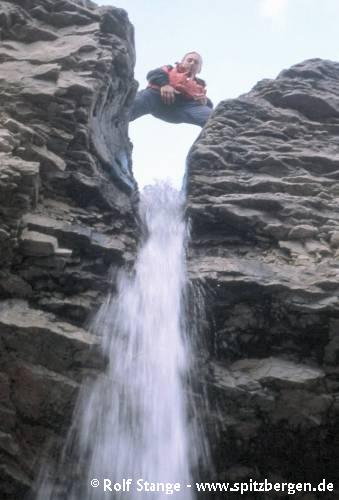
In southern Dickson Land, landscapes within the Triassic sediments remind one of similar places for example in eastern Nordenskiöld Land (east of Longyearbyen), Edgeøya etc. Here, doleritic intrusions sometimes form irregular ridges and cliffs in the slopes. Small ice caps cover parts of the high plateaus, which are dissected by steep canyons.
In central northern Dickson Land, the Old Red with its nicely reddish-brown sandstones and conglomerates dominates the appareance of the landscape; here you find large, ice-free valleys with warm colours on the soft lower and middle slopes (Hudindalen, Nathorstdalen). On top of these slopes, hard carbonates form steep cliffs, so it is often difficult to reach the summit.
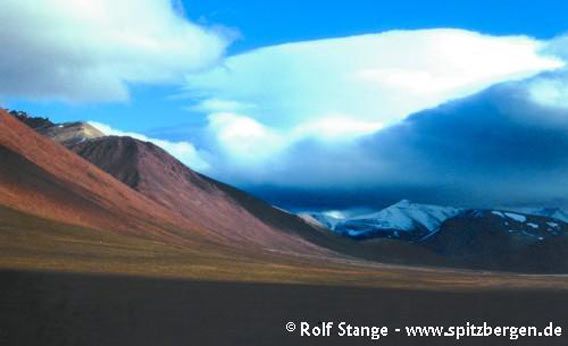
Tundra in Nathorstdalen with slopes composed of Old Red sandstone with its warm colours.
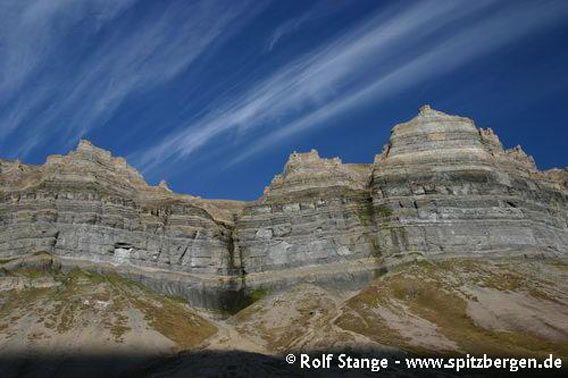
Skansbukta.
Further north, around Ålandvatnet and Mittag-Lefflerbreen, metamorphic basement and sedimentary cover rocks form a mosaic because of the tectonics related to the Billefjorden fault zone (see above). In the area of cover rocks, you find some nice, colourful mountains, the slopes of which are sometimes nicely dissected by erosion to form regular towers. In contrast, the harder basement rocks form steeper mountain slopes with a more irregular, inpredictable appereance. Near Mittag Lefflerbreen, huge morains form chaotic, ever-changing landscapes (Ålandsvatnet, Hoglandvatnet).
Flora and Fauna: There is quite rich tundra near the coast and in some of the large, ice-free valleys of Dickson Land. On steep cliffs, there are colonies of seabirds, but otherwise, this part of central Spitsbergen does not have too much wildlife. Around the Billefjord, there are small numbers of reindeer, but despite of having been there quite often, I have seen them very few times only.
History: I do not know of any activities of 17th century whalers in the area. Pomors used the area as well as Norwegian trappers; especially Dickson Fjord which was home to the legendary Arthur Oxaas between the wars. The Billefjord was used for mining on a number of occasions in the 20th century. The SSS (Scottish Spitsbergen Syndicate, with William Spierce Bruce) investigated Carboniferous coal seams east of the Billefjord in Brucebyen, which they built for this purpose. Another early attempt to explore minerals was done by the ‘Portland Cement Fabric’, which established mining facilities in Skansbukta, but here as well as in other places the occurrence turned out to be economically worthless. The entrance to the mine as well as someold machinery can still be seen. Large-scale mining was done in Pyramiden. Founded 1910 by a Swedish company, Russians to over the area in 1926. But mining did not seriously start until 1940 and was, with interruptions, continued until 1998, when the mine was finally abandoned.
Remains of a gypsym mine in Skansbukta.
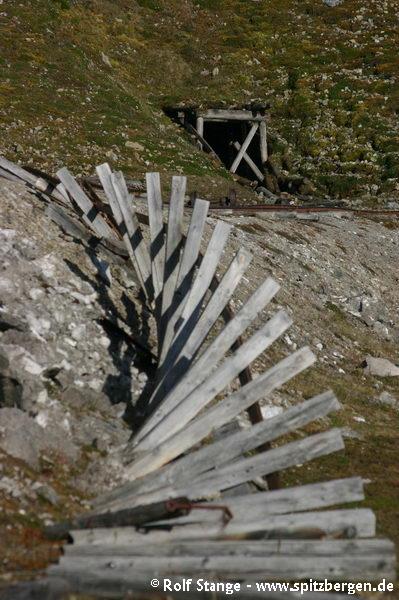
BOOKS, CALENDAR, POSTCARDS AND MORE
This and other publishing products of the Spitsbergen publishing house in the Spitsbergen-Shop.
last modification: 2013-10-11 ·
copyright: Rolf Stange


































